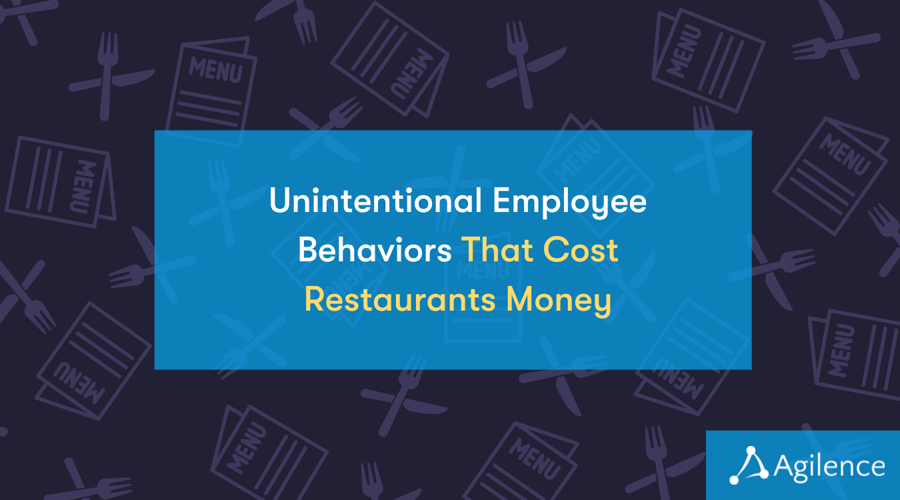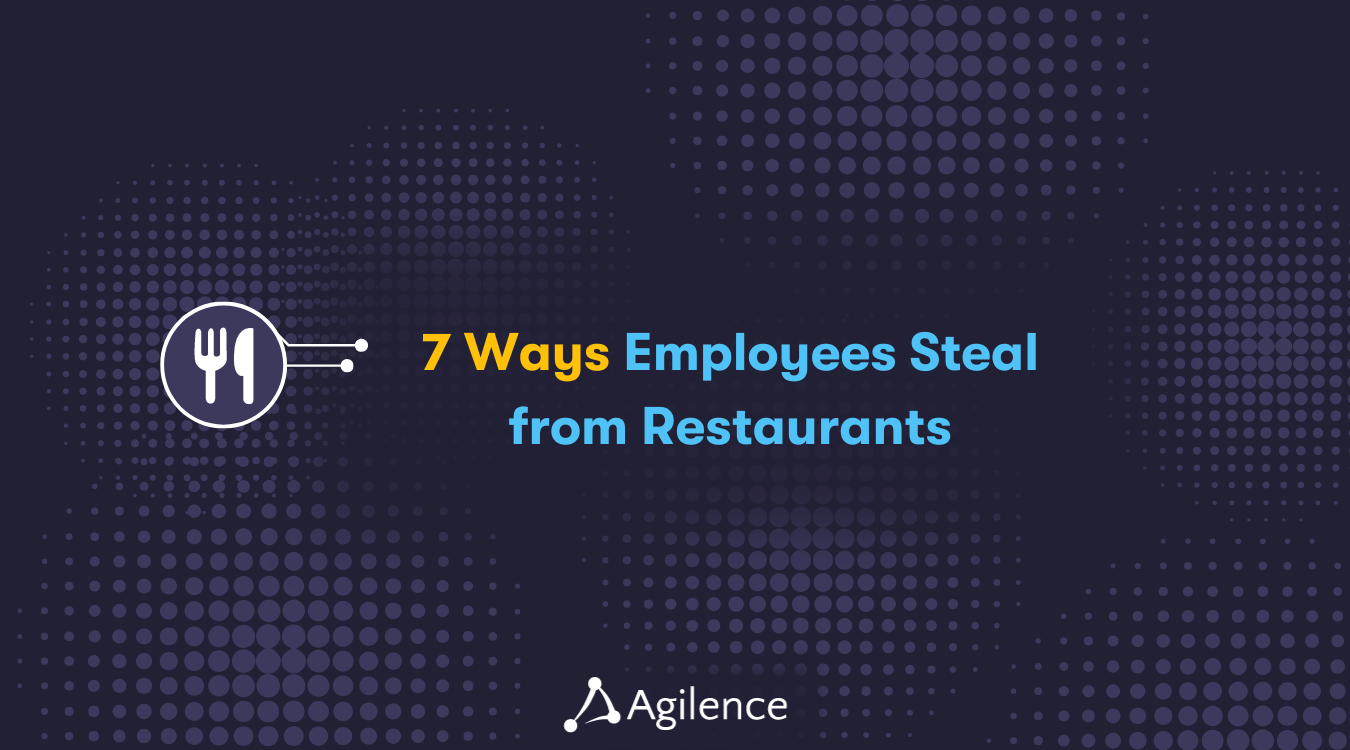Unintentional Employee (and Manager) Behaviors That Cost Restaurants Money
Restaurant
While employee theft is the biggest contributor to shrink in restaurants, it’s not the only employee behavior hurting restaurant margins. Unintentional employee behaviors can also hurt the bottom line. And with a labor shortage and increasingly high turnover among restaurant employees, many stores can’t train new staff as thoroughly as needed to avoid some of these behaviors.
The good news is, unlike intentional theft, many of these behaviors can be corrected by identifying and then training and incentivizing employees to change. While some of these behaviors may appear small, repeated costly actions by your team can add up to surprisingly big impacts on margins. In this article we explore unintentional employee (and manager) behaviors that cost restaurants money.
Wasting food and other supplies
Food costs are one of the biggest costs for your restaurant and keeping them under control is key to maintaining profitability. Various employee behaviors, from accidents to not properly controlling portion sizes, can lead to unnecessary increased costs. While accidents and mistakes are part of doing business, consistent waste increases operational costs, and can be fixed by monitoring and training staff to correct those issues.
When you look at your POS data, you get a theoretical number on what your food cost should be based on what you’ve sold. However, when your team does inventory, the actual inventory will often have a discrepancy between the theoretical number from your sales data. The delta between these two is where employee waste occurred.
To minimize waste, you need to attribute sources of loss to their causes. Was the inventory loss caused by accident, by not following procedure, or by lacking proper procedures in the first place? Or were they caused by intentional employee theft? By using Agilence Analytics and cross-referencing with video data, you can track loss events to their source.
Then, discover where the issues are that need to be fixed. Are employees wasting disposable items? Do portion sizes need to be controlled? Did food costs go up at a certain store location? If so, you may want to check the cameras and open a case to identify the cause of an unexpected spike in costs. While some accidental loss will always occur, you can minimize preventable loss through monitoring and training.
Not properly charging guests
Comping meals or certain items to satisfy an unhappy guest is common restaurant practice. However, sometimes employees will overuse this power, often in an attempt to receive a bigger tip. One common issue we see is waiters routinely not charging for nonalcoholic beverages such as sodas. If your restaurant has a soda machine, it may not seem like a big deal to fill up the cups for the guests and expect that they’ll pay you back when it comes time for the tip.
However, this quickly adds up. We’ve seen table serve chains with locations losing thousands of dollars a month due to employees giving out free sodas. One way to identify this is by using Agilence to look at the KPI Beverages Per Entree. If a disproportionate number of entrees are served with only a cup of water, the location you’re looking at is likely facing this issue.
Lack of upselling
One often overlooked but significant unintentional employee behavior that costs restaurants money is the lack of upselling. Upsells are key to increasing restaurant sales. When servers miss opportunities to recommend higher-priced items, add-ons, or specials, the restaurant loses potential revenue on each transaction. This shortfall accumulates over time, significantly impacting overall profit margins.
Agilence Analytics can play a pivotal role in identifying this issue by analyzing sales data to spotlight trends and patterns in ordering. For instance, if certain items that are commonly upsold together rarely appear on the same ticket, it may indicate missed upselling opportunities. Reports on ticket averages can alert you to which employees aren’t attempting to upsell. By leveraging such insights, restaurant owners and operators can pinpoint which employees might benefit from additional training on upselling techniques, ultimately turning these missed opportunities into increased revenue and improved customer satisfaction.
Inefficient table turns
Table turnover is a key metric for measuring your restaurant’s efficiency. Inefficient table turning and poor time management by restaurant staff is another subtle yet impactful behavior that can erode a restaurant's profitability. When tables are not turned efficiently, the result is fewer guests served per shift, directly affecting daily revenue. This inefficiency often stems from poor time management, including slow order taking, delayed food service, and procrastinated table clearing and resetting.
Utilizing Agilence Analytics, restaurant owners and operators can gain insights into service times and identify bottlenecks in the dining experience. By analyzing data on the duration guests spend at tables and comparing it across different times of the day or with different staff members, Agilence can highlight areas where processes should be optimized. This enables targeted interventions, such as staff retraining or procedural adjustments, to enhance operational efficiency, improve customer turnover rates, and ultimately boost the restaurant's bottom line.
Improper food storage and handling/negligence in following protocols
Employee negligence in following protocols, such as for proper food storage and handling or equipment maintenance, represent critical areas where unintentional employee behaviors can substantially cost restaurants money. Poor practices in these areas can lead to increased food spoilage and waste, elevating food costs and decreasing margins. For instance, failing to store food at the correct temperature or mixing stored foods can cause premature spoilage or pose health risks, leading to potential loss of inventory and, even worse, foodborne illnesses among guests, which could result in hefty fines and damage to the restaurant's reputation.
Additionally, negligence in adhering to cleaning and maintenance protocols can cause equipment to fail earlier than expected, leading to expensive repairs or replacements. Fostering a culture of accountability and using store audits to track and ensure protocols are being followed can help. Agilence Store Audit is a comprehensive, easy-to-use solution for building, scoring, and conducting store audits.
Unintentional employee “theft”
Unintentional theft? It may sound like an oxymoron. No, we’re not talking about accidentally walking out with the cash drawer, but rather a variety of ways employees unintentionally contribute to losses through mishandling of checks or restaurant funds, improper discounting, incorrect void processing, erroneous order entries or inaccurate tip reporting, which can negatively affect the restaurant's revenue and compliance with tax laws.
For example, an employee might unintentionally key in a lower-priced item instead of the chosen premium option, or forget to charge for add-ons, resulting in underreported sales. Even time theft isn’t always intentional – sometimes employees just genuinely forget to clock out and it goes unnoticed. Over time, these small discrepancies can accumulate, leading to a substantial drain on profits. Additionally, such practices, when unnoticed, can inadvertently encourage a lax culture around adherence to pricing and billing procedures. Agilence Analytics can help you identify these anomalies in the same way you would intentional theft.
Inefficient staff scheduling by managers
With the current labor shortage, restaurant managers need tomust be judicious about scheduling employees. And with labor costs rising, it is crucial that restaurants do everything they can to minimize labor costs while ensuring their locations are properly staffed at key times to provide a quality customer experience.
Analytics can help restaurant managers align staff schedules with peak business hours to avoid overstaffing or understaffing and, negatively affecting labor costs or service quality. By looking at your sales patterns, managers can make informed decisions when it's time to create schedules.
Analytics can also help avoid unnecessary overtime, which can greatly increase labor costs. Managers can receive an alert when an employee is close to hitting their max allotted hours, ensuring employees don’t accidentally go into overtime territory.
Labor costs are one of the biggest contributors to overall restaurant costs, typically making up around 30% of costs and contributing a major portion of a restaurant’s prime cost. With the price of labor rising, getting labor costs under control is more important than ever.
Positive Uses of Analytics in Restaurant Operations
Now you might be thinking that using a restaurant analytics tool like Agilence is all about monitoring and catching employees making mistakes, but that doesn’t have to be the case. Analytics is about understanding what’s going on in your stores, so you can make decisions and improve operations accordingly. That includes the good and the bad. What you do with that information is up to you. Here are some positive ways to use analytics when looking at employee behaviors:
- Identifying Key Employees: Analytics can help pinpoint high-performing employees who excel during peak times or in specific sections of the restaurant. Recognizing these employees allows management to reward these employees and allocate staffing more strategically to optimize service and sales.
- Incentivizing Employees: By analyzing sales data, restaurants can implement incentive programs for employees. For example, contests to see who can sell the most of a particular item, like a specialty margarita or a new dish, can motivate staff and increase sales.
- Enhancing Marketing Efforts: Analytics can evaluate the success of limited time offers by tracking sales data for specific items, such as seasonal drinks or promotional burgers. This helps in understanding customer preferences and the effectiveness of marketing strategies.
- Monitoring Charitable Contributions: In contexts where restaurants engage in charitable activities, like donation roundups at the point of sale, analytics can track which employees are most effective in encouraging customer participation, potentially applying similar strategies to sales.
- Compliance with Labor Laws: Restaurants need to navigate complex labor laws, which can vary significantly by location, such as in California where regulations around the employment of minors are particularly stringent. An analytics solution can help ensure compliance by monitoring work hours and tasks assigned to minors, reducing the risk of inadvertently violating laws.
- Monitoring Work Assignments: With the right data, a restaurant can ensure that minors are not assigned to tasks that are prohibited for their age group, such as operating heavy machinery like a large Hobart mixer or serving alcoholic beverages.
Agilence Analytics for Restaurants comes with a number of pre-built reports and dashboards out of the box, specifically designed for minimizing shrink. These dashboards, combined with alerts, make it easier to identify sales-reducing behaviors and can reveal fraudulent activities, discount abuse, voided transactions, return and cancellation patterns, employee behavior outliers, and much more.
Learn more about combating employee behaviors that are hurting your margins using analytics.
Related Articles

How to Calculate and Control Restaurant Food Cost: Comprehensive Guide
When it comes to ensuring profitability for your restaurants, cost control is essential to hitting your margins. In 2023, eve...
How to Calculate and Control Your Restaurant’s Labor Costs
According to the National Restaurant Association, 89% of restaurant operators surveyed at the end of 2022 said that labor cos...
7 Ways Employees Steal from Restaurants
Employees are the core of any business, but this is especially true in restaurants. It is the service industry after all. Alt...Subscribe to our blog
Receive free educational resources like exclusive reports, webinars, and industry thought leadership articles straight to your inbox.

